1993 CHEVROLET CAVALIER air condition
[x] Cancel search: air conditionPage 102 of 308
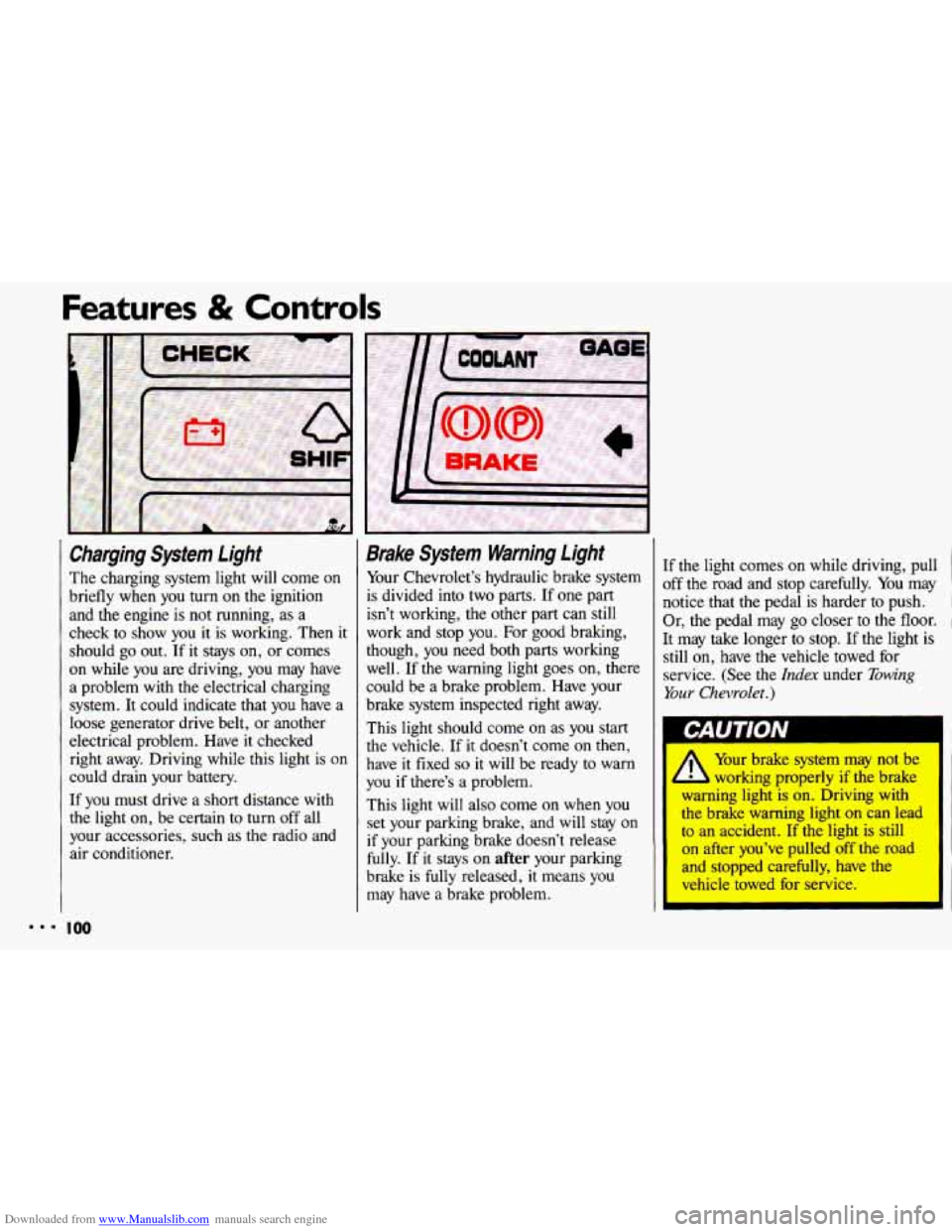
Downloaded from www.Manualslib.com manuals search engine Features & Controls
Charging System Light
The charging system light will come on
briefly when
you turn on the ignition
and the engine is not running, as a
check to show you it is working. Then it
should go out. If it stays on, or comes
on while you are driving, you may have
a problem with the electrical charging
system.
It could indicate that you have a
loose generator drive belt, or another
electrical problem. Have
it checked
right away. Driving while this light is on
could drain your battery.
If you must drive a short distance with
the light on, be certain to turn off all
your accessories, such as the radio and
air conditioner.
Brake Sysfem Warning Light
Your Chevrolet’s hydraulic brake system
is divided into two parts. If one part
isn’t working, the other part can still
work and stop you. For good braking,
though, you need both parts working
well. If the warning light goes on, there
could be a brake problem. Have your
brake system inspected right away.
This light should come on as you start
the vehicle. If it doesn’t come on then,
have
it fixed so it will be ready to warn
you if there’s
a problem.
This light will also come on when you
set your parking brake, and will stay
on
if your parking brake doesn’t release
fully. If it stays
on after your parking
brake is fully released,
it means you
may have
a brake problem. If
the light comes
on while driving, pull
off the road and stop carefully. You may
notice that the pedal is harder to push.
I
Or, the pedal may go closer to the floor. 1
It may take longer to stop. If the light is
still on, have the vehicle towed for
service. (See the
Index under Towing
Your Chevrolet.)
L-AU I IVN
I
/1 Your brake system may not be
L working properly if the brake
warning light is on. Driving with
the brake warning light
on can lead
to an accident. If the light is still
on after you’ve pulled off the road
and stopped carefully, have the
vehicle towed for service.
I
Page 107 of 308
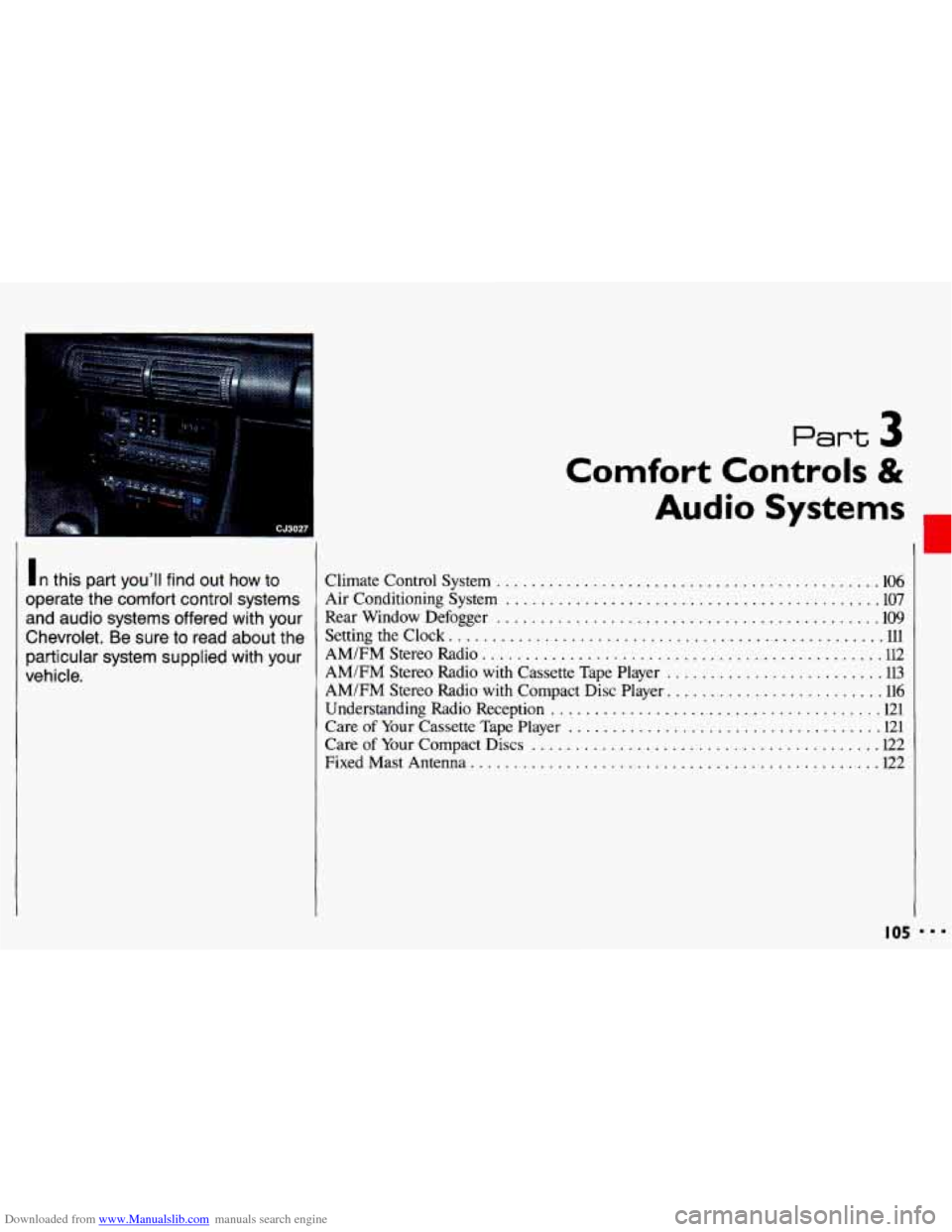
Downloaded from www.Manualslib.com manuals search engine Part 3
In this part you’ll find out how to
operate the comfort control systems
and audio systems offered with your
Chevrolet
. Be sure to read about the
particular system supplied with your
vehicle
.
Comfort Controls &
Audio Systems
Climate Control System ............................................ 106
Air Conditioning System ........................................... 107
Rear Window Defogger
............................................ 109
Setting the Clock .................................................. 111
AM/FM Stereo Radio
.............................................. 112
AM/FM Stereo Radio with Cassette Tape Player ......................... 113
AM/FM Stereo
Radio with Compact Disc Player ......................... 116
Understanding Radio Reception
...................................... 121
Care
of Your Cassette Tape Player .................................... 121
Care
of Your Compact Discs ........................................ 122
Fixed Mast Antenna
............................................... 122
I05
Page 109 of 308
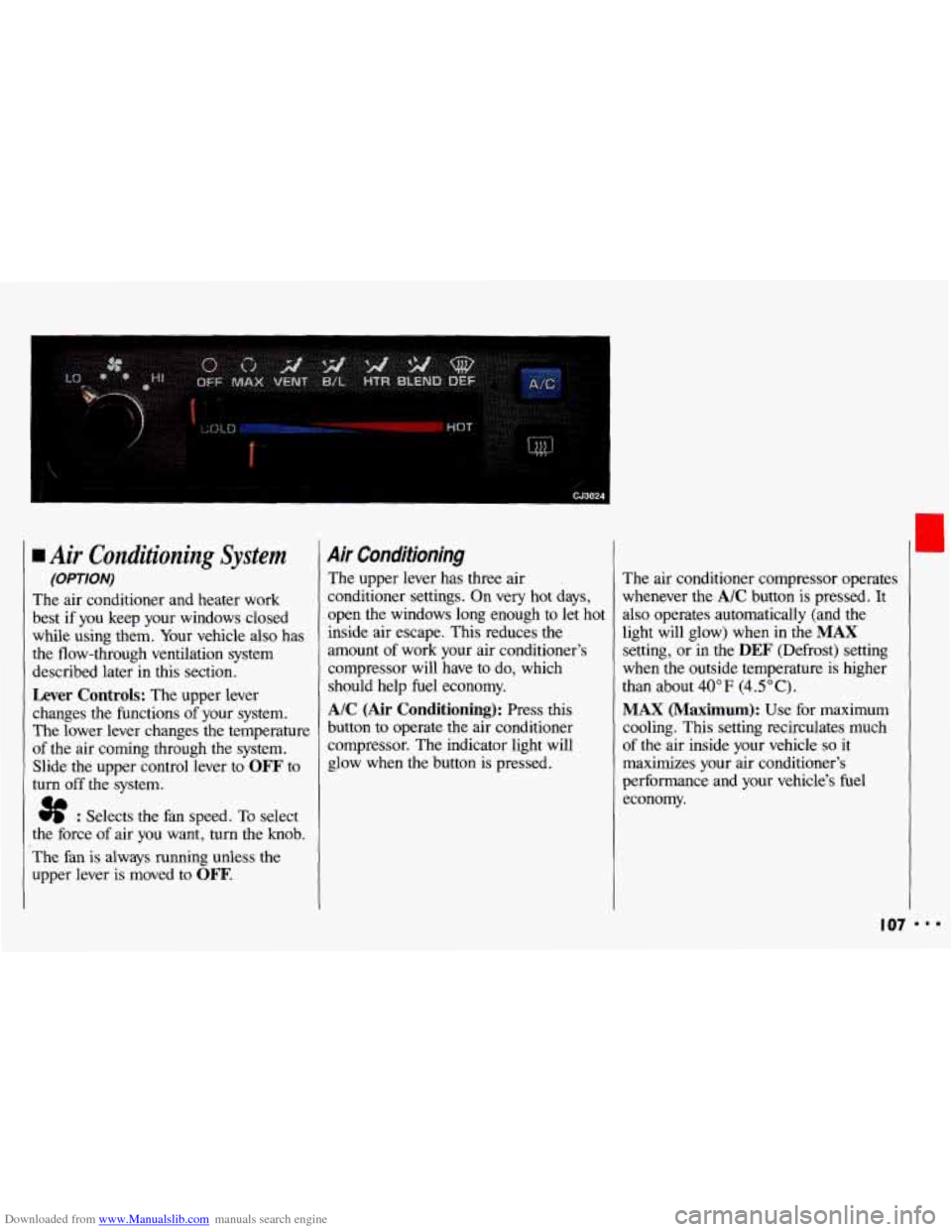
Downloaded from www.Manualslib.com manuals search engine r
Air Conditioning System
(OPTION)
The air conditioner and heater work
best if you keep your windows closed
while using them. Your vehicle also has
the flow-through ventilation system
described later in this section.
Lever Controls: The upper lever
changes the functions
of your system.
The lower lever changes the temperature
of the air coming through the system.
Slide the upper control lever to
OFF to
turn off the system.
I 3f : Selects the fan speed. To select
the force of air you want, turn the knob.
The fan is always running unless the
upper lever is moved to
OFF.
Air Conditioning
The upper lever has three air
conditioner settings.
On very hot days,
open the windows long enough to let hot
inside air escape. This reduces the
amount of work your air conditioner's
compressor will have to do, which
should help fuel economy.
A/C (Air Conditioning): Press this
button to operate the air conditioner
compressor. The indicator light will
glow when the button
is pressed. The air conditioner compressor
operates
whenever the
AIC button is pressed. It
also operates automatically (and the
light will glow) when in the
MAX
setting, or in the DEF (Defrost) setting
when the outside temperature is higher
than about
40°F (4.5"C).
MAX (Maximum): Use for maximum
cooling. This setting recirculates much
of the air inside your vehicle
so it
maximizes your air conditioner's
performance and your vehicle's fuel
economy.
I07
r
IIB
Page 110 of 308
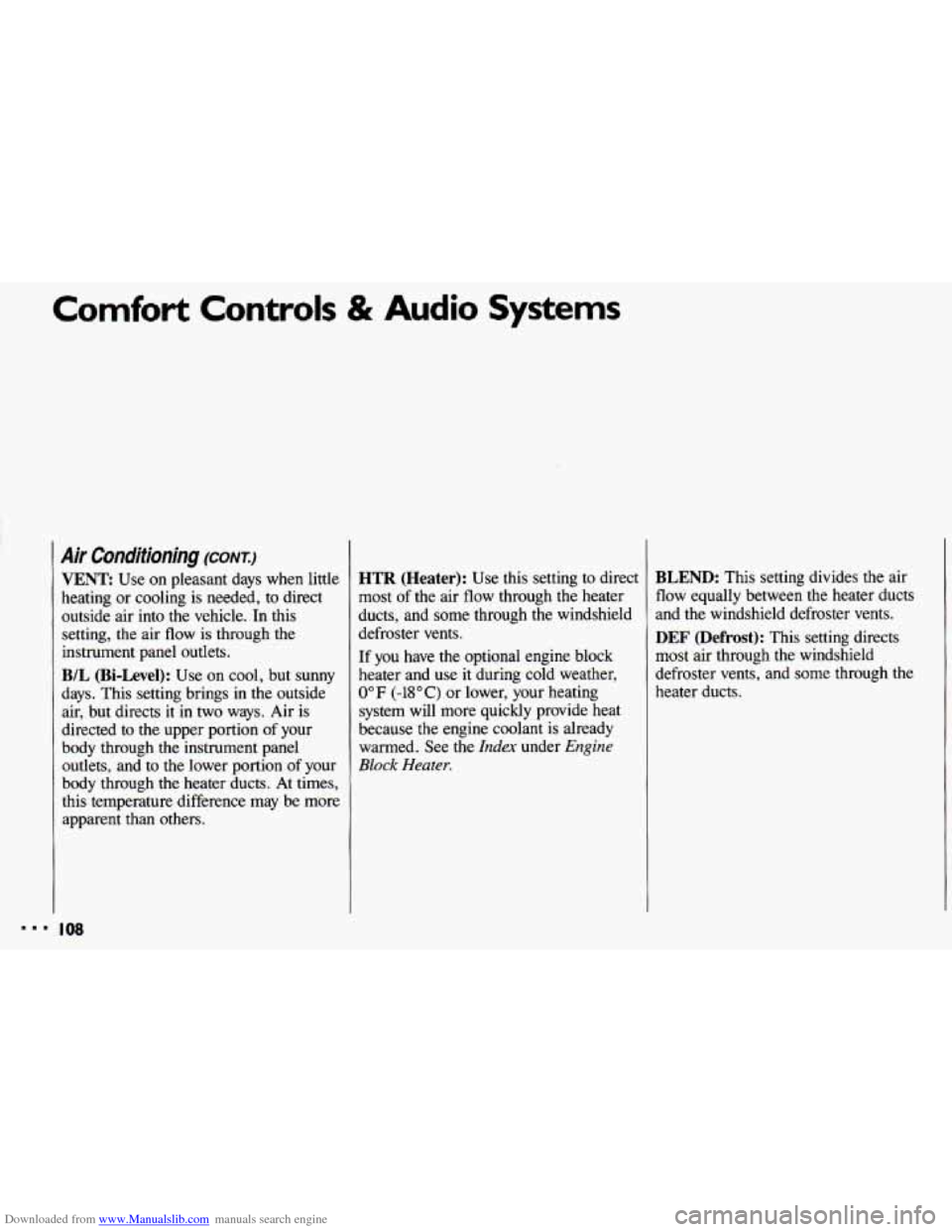
Downloaded from www.Manualslib.com manuals search engine Comfort Controls & Audio Systems
Air Conditioning (CONX:)
VENT Use on pleasant days when little
heating or cooling is needed,
to direct
outside air into the vehicle.
In this
setting, the air flow
is through the
instrument panel outlets.
B/L (Bi-Level): Use on cool, but sunny
days. This setting brings in the outside
air, but directs it in two ways. Air is
directed to the upper portion
of your
body through the instrument panel
outlets, and to the lower portion of your
body through the heater ducts. At times,
this temperature difference may be more
apparent than others.
HTR (Heater): Use this setting to direct
most of the air flow through the heater
ducts, and some through the windshield
defroster vents.
If
you have the optional engine block
heater and use
it during cold weather,
0°F (-18°C) or lower, your heating
system will more quickly provide
heat
because the engine coolant is already
warmed. See the
Index under Engine
Block Heater.
BLEND: This setting divides the air
flow equally between the heater ducts
and the windshield defroster vents.
DEF (Defrost): This setting directs
most air through the windshield
defroster vents, and some through the
heater ducts.
Page 111 of 308
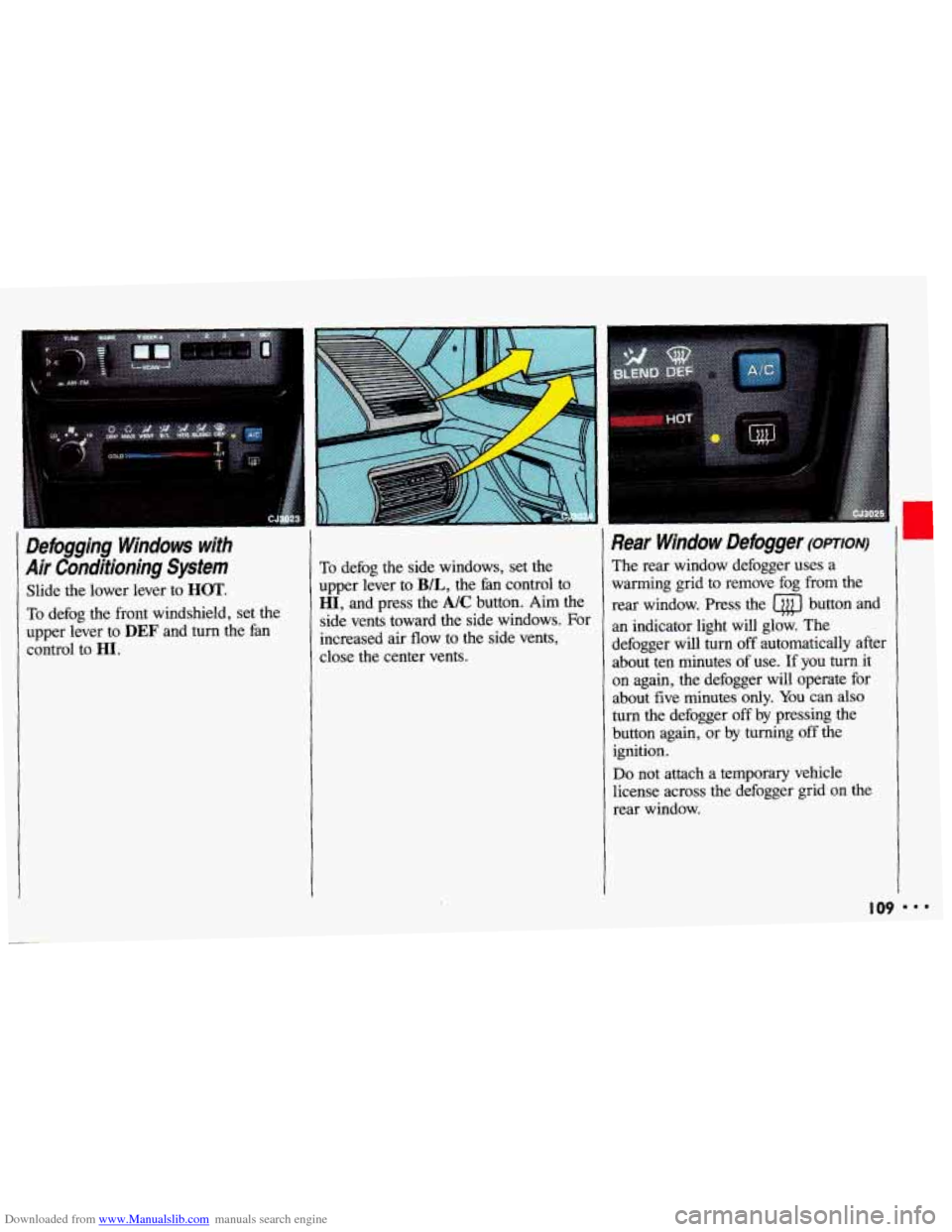
Downloaded from www.Manualslib.com manuals search engine i; . ... ..- -. . ,' $,
Defogging Windows with
Air Conditioning System
Slide the lower lever to HOT.
To defog the front windshield, set the
upper lever to
DEF and turn the fan
control to HI.
To defog the side windows, set the
upper lever to
B/L, the fan control to
HI, and press the A/C button. Aim the
side vents toward the side windows. For
increased air flow to the side vents,
close the center vents.
Rear Window Defogger (omoN)
The rear window defogger uses a
warming grid to remove fog from the
rear window. Press the
a button and
an indicator light will glow. The
defogger will turn
off automatically after
about ten minutes of use. If you
turn it
on again, the defogger will operate for
about five minutes
only. You can also
turn the defogger off by pressing the
button again, or by turning off the
ignition.
Do not attach a temporary vehicle
license across the defogger grid on
the
rear window.
I09 I..
Page 112 of 308
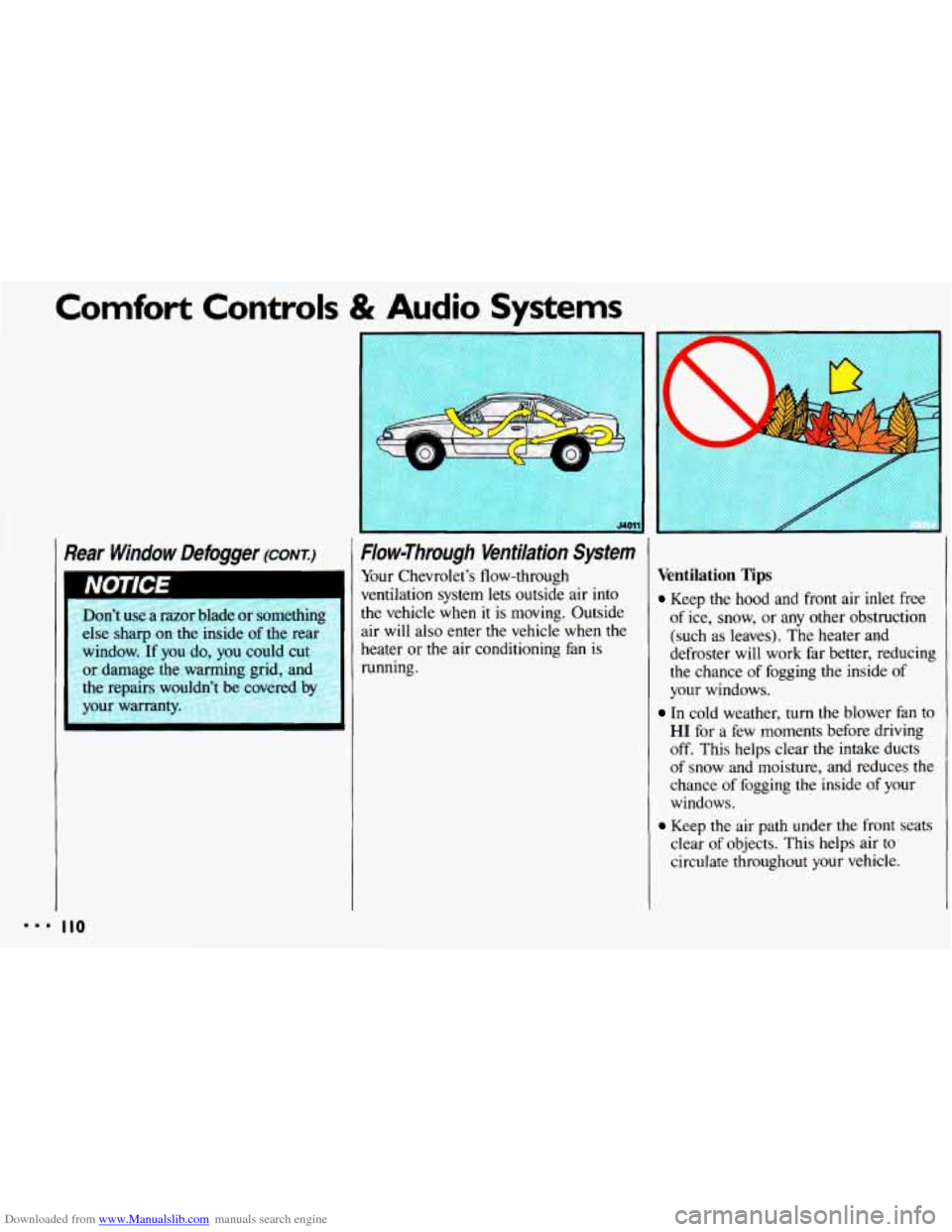
Downloaded from www.Manualslib.com manuals search engine Comfort Controls & Audio Systems
r
?ear Window Defogger (cow.)
Don’t use a razor blade or something
else sharp on the inside
of the rear
window. If you do,
you could cut
or damage
the warming grid, and
the repairs wouldn’t be covered by
your warranty.
Flow-Through Ventilation System
Your Chevrolet’s flow-through
ventilation system lets outside air into
the vehicle
when it is moving. Outside
air
will also enter the vehicle when the
heater or the air conditioning fan is
running.
Ventilation Tips
Keep the hood and front air inlet free
of ice, snow, or any other obstruction
(such as leaves). The heater and
defroster
will work far better, reducing
the chance
of fogging the inside of
your windows.
In cold weather, turn the blower fan to
HI for a few moments before driving
off.
This helps clear the intake ducts
of snow and moisture, and reduces the
chance of fogging the inside of your
windows.
Keep the air path under the front seats
clear of objects. This helps air
to
circulate throughout your vehicle.
Page 177 of 308

Downloaded from www.Manualslib.com manuals search engine If you get the overheat warning with no
sign
of steam, try this for a minute or so:
1. If you have an air conditioner, turn it
2. Turn on your heater to full hot at the
off.
highest fan speed and open the window as necessary.
3. Try to keep your engine under load
(in a drive gear where the engine
runs slower).
If
you no longer have the overheat
warning, you can drive. Just to be safe,
drive slower for about ten minutes. If
the warning doesn’t come back on, you
can drive normally.
If the warning continues, pull over, stop, and park your vehicle right away. If there’s
still no sign of steam, you can
idle the engine for two or three minutes
while you’re parked, to see
if the
warning stops. But then, if you still have
the warning, TURN
OFF THE
ENGINE AND
GET EVERYONE
OUT OF THE VEHICLE until it cools
down.
You may decide not to
lift the hood but
to get service help right away.
If you have
a 2.2L L4 engine, your
engine coolant system
will have a
coolant recovery
tank. If you have a 3.1L
V6 engine, your engine coolant system
will have a coolant surge tank.
There are important differences between
these two cooling systems. Read this section carefully.
Cooling System-2.2L LA Engine
When you decide it’s safe to lift the
hood, here’s what you’ll see:
(A) Coolant recovery tank
(B) Radiator pressure cap
(C) Electric engine fan
a An electric fan under the hood
engine
is not running and can injure
you. Keep hands, clothing and tools
away
from any underhood electric h.
L can start up even when the
If the coolant inside the coolant
recovery tank
is boiling, don’t do
anything else until it cools down.
I75
Page 236 of 308
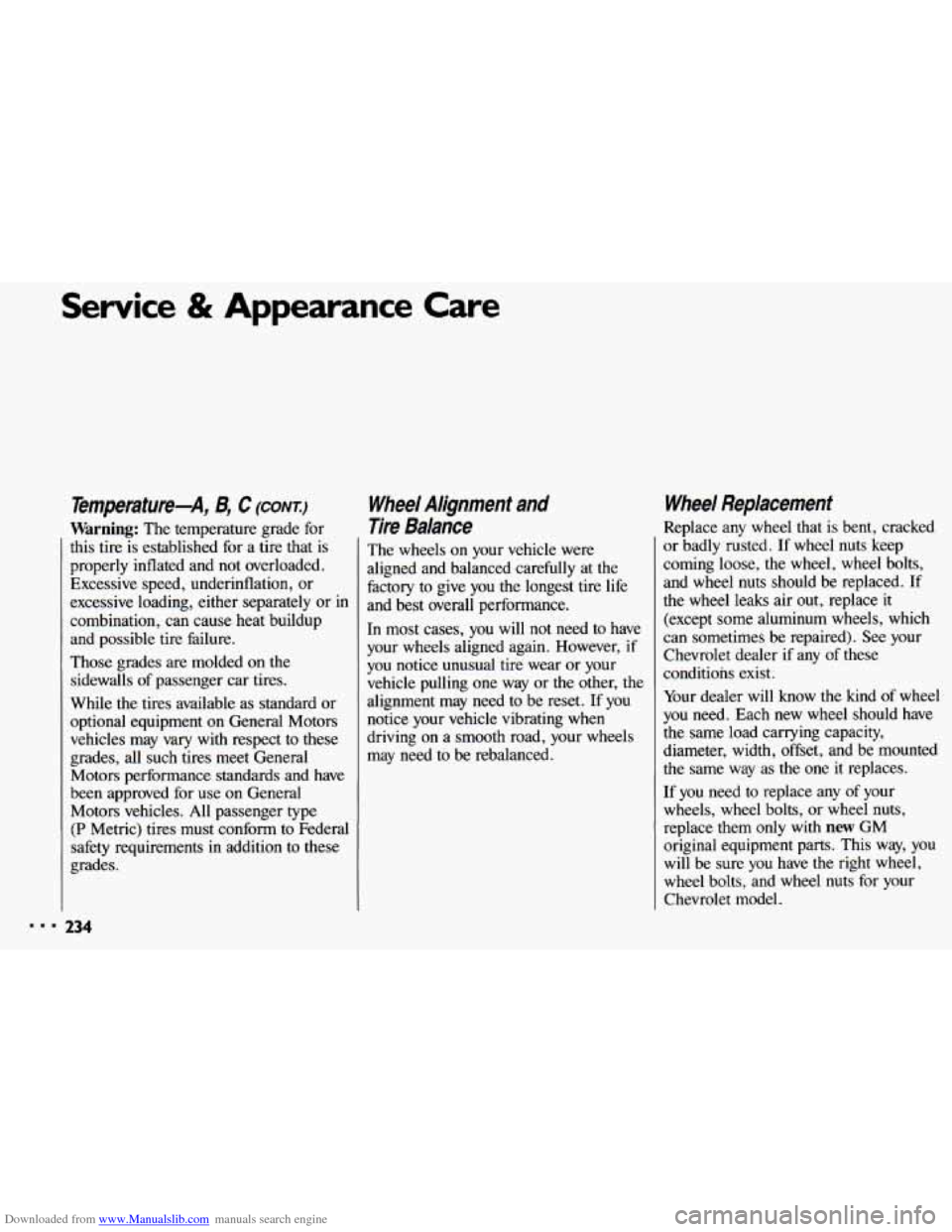
Downloaded from www.Manualslib.com manuals search engine Service & Appearance Care
Temperature-A, 8, C ~NTJ
Warning: The temperature grade for
this tire is established for a tire that is
properly inflated and not overloaded.
Excessive speed, underinflation,
or
excessive loading, either separately or in
combination, can cause heat buildup
and possible tire failure.
Those grades are molded on the
sidewalls of passenger car tires.
While
the tires available as standard or
optional equipment on General Motors
vehicles may vary
with respect to these
grades, all such tires meet General
Motors performance standards and have
been approved for use on General Motors vehicles.
All passenger type
(P Metric) tires must conform to Federal
safety requirements in addition to these
grades.
234
Wheel Alignment and
Tire Balance
The wheels on your vehicle were
aligned and balanced carefully at the
factory to give you the longest tire life
and best overall performance.
In most cases, you
will not need to have
your wheels aligned again. However,
if
you notice unusual tire wear or your
vehicle pulling one way or the other, the
alignment may need to be reset. If you
notice your vehicle vibrating when
driving on a smooth road, your wheels
may need to be rebalanced.
Wheel Replacement
Replace any wheel that is bent, cracked
or badly rusted. If wheel nuts keep
coming loose, the wheel, wheel bolts,
and wheel nuts should be replaced. If
the wheel leaks air out, replace
it
(except some aluminum wheels, which
can sometimes be repaired). See your
Chevrolet dealer if any of these
conditions exist.
Your dealer
will know the kind of wheel
you need. Each new wheel should have
the same load carrying capacity,
diameter, width, offset, and be mounted
the same way as the one
it replaces.
If you need to replace any of your
wheels, wheel bolts, or wheel nuts,
replace them only
with new GM
original equipment parts. This way, you
will be sure you have the right wheel,
wheel bolts, and wheel nuts for your
Chevrolet model.